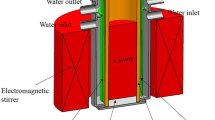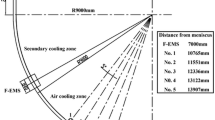Abstract
Solidification cracking that occurs during continuous casting of 1Cr13 stainless steel was investigated with and without final electromagnetic stirring (F-EMS). The results show that cracks initiates and propagates along the grain boundaries where the elements of carbon and sulfur are enriched. The final stirrer should be appropriately placed at a location that is 7.5 m away from the meniscus, and the appropriate thickness of the liquid core in the stirring zone is 50 mm. As a stirring current of 250 A is imposed, it can promote columnar-equiaxed transition, decrease the secondary dendrite arm spacing, and reduce the segregation of both carbon and sulfur. F-EMS can effectively decrease the amount of cracks in 1Cr13 stainless steel.
Similar content being viewed by others
References
P. Wen, Z.P. Cai, Z.H. Feng, and G. Wang, Microstructure and mechanical properties of hot wire laser clad layers for repairing precipitation hardening martensitic stainless steel, Opt. Laser Technol., 75(2015), p. 2015.
J.Q. Yang, Y. Liu, Z.Y. Ye, D.Z. Yang, and S.H. Ye, Microstructure and tribological characteristics of nitrided layer on 2Cr13 steel in air and vacuum, Surf. Coat. Technol., 204(2009), No. 5, p. 705.
B.G. Scuracchio and C.G. Schön, Influence of alloying elements upon the solidification interval of CA6NM cast martensitic stainless steel, J. Phase Equilib. Diff., 33(2012), No. 2, p. 115.
M.H. Trejo, E.A. Lopez, J.J.R. Mondragon, M.J.C. Roman, and H.S. Tovar, Effect of solidification path and contraction on the cracking susceptibility of carbon peritectic steels, Met. Mater. Int., 16(2010), No. 5, p. 731.
J. Konishi, M. Militzer, I.V. Samarasekera, and J.K. Brimacombe, Modeling the formation of longitudinal facial cracks during continuous casting of hypoperitectic steel, Metall. Mater. Trans. B, 33(2002), No. 3, p. 413.
D.M. Stefanescu, Microstructure evolution during the solidification of steel, ISIJ Int., 46(2006), No. 6, p. 786.
S. Kou, A criterion for cracking during solidification, Acta Mater., 88(2015), p. 2015.
L.G. Zhu and R.V. Kumar, Shrinkage of carbon steel by thermal contraction and phase transformation during solidification, Ironmaking Steelmaking, 34(2007), No. 1, p. 71.
K. Kim, H.N. Han, T. Yeo, Y. Lee, K.H. Oh, and D.N. Lee, Analysis of surface and internal cracks in continuously cast beam blank, Ironmaking Steelmaking, 24(1997), No. 3, p. 249.
Z.Q. Han, K. Cai, and B.C. Liu, Prediction and analysis on formation of internal cracks in continuously cast slabs by mathematical models, ISIJ Int., 41(2001), No. 12, p. 1473.
M. Deisinger and K.H. Tacke, Unbending of continuously cast slabs with liquid-core, Ironmaking Steelmaking, 24(1997), No. 4, p. 321.
M.R. Ridolfi, Hot tearing modeling: a microstructural approach applied to steel solidification, Metall. Mater. Trans. B, 45(2014), No. 4, p. 1425.
H.J. Wu, N. Wei, Y.P. Bao, G.X. Wang, C.P. **ao, and J.J. Liu, Effect of M-EMS on the solidification structure of a steel billet, Int. J. Miner. Metall. Mater., 18(2011), No. 2, p. 159.
L. Bettlman, Effect of mold EMS design on billet casting productivity and product quality, Can. Metall. Q., 38(1999), No. 5, p. 301.
K.S. Oh and Y.W. Chang, Macrosegregation behavior in continuously cast high carbon steel blooms and billets at the final stage of solidification in combination stirring, ISIJ Int., 35(1995), No. 7, p. 866.
M. Raj and J.C. Pandey, Optimisation of electromagnetic stirring in continuously cast steel billets using ultrasonic C-scan imaging technique, Ironmaking Steelmaking, 35(2008), No. 4, p. 28.
C. **ao, J.M. Zhang, Y.Z. Luo, X.D. Wei, L. Wu, and S.X. Wang, Control of macrosegregation behavior by applying final electromagnetic stirring for continuously cast high carbon steel billet, J. Iron steel Res. Int., 20(2013), No. 11, p. 1.
Y.N. Yu, Principles of Metallography, Metallurgy Industry Press, Bei**g, 2000, p. 248.
J.M. Cabrera-Marrero, V. Carreño-Galindo, R.D. Morales, and F. Chávez-Alcalá, Macro-micro modeling of the dendritic microstructure of steel billets processed by continuous casting, ISIJ Int., 38(1998), No. 8, p. 812.
W.Z. **, T.J. Li, and G.M. Yin, Research on vacuum-electromagnetic casting of IN100 superalloy ingots, Sci. Technol. Adv. Mater., 8(2007), No. 1-2, p. 1.
Author information
Authors and Affiliations
Corresponding author
Rights and permissions
About this article
Cite this article
Xu, Y., Xu, Rj., Fan, Zj. et al. Analysis of cracking phenomena in continuous casting of 1Cr13 stainless steel billets with final electromagnetic stirring. Int J Miner Metall Mater 23, 534–541 (2016). https://doi.org/10.1007/s12613-016-1264-6
Received:
Revised:
Accepted:
Published:
Issue Date:
DOI: https://doi.org/10.1007/s12613-016-1264-6




